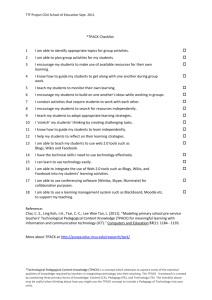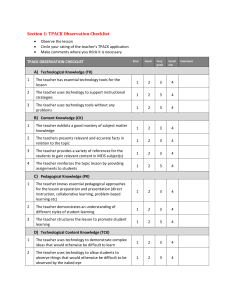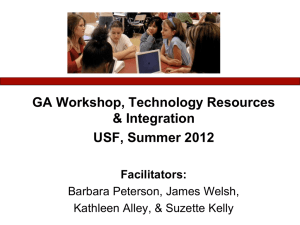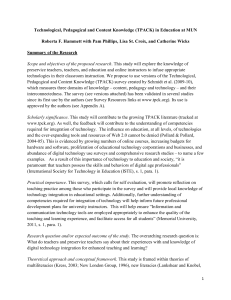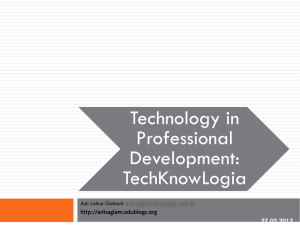Forssell Ch 2 Background 5.11.11 CHAPTER 2: Background In this
advertisement
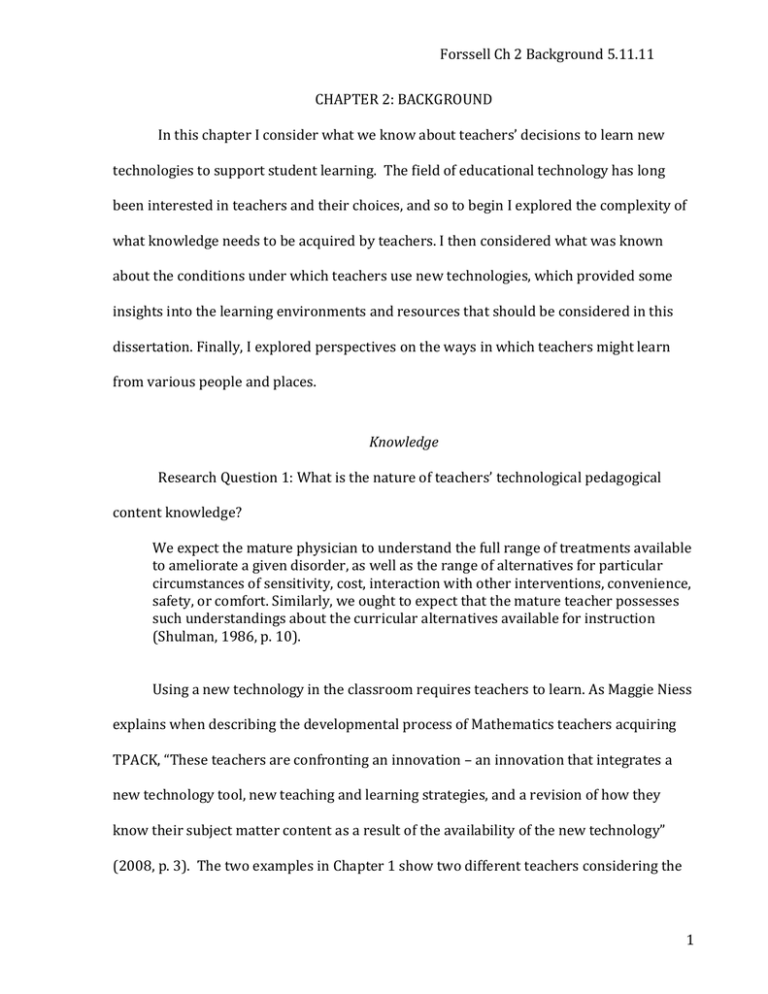
Forssell Ch 2 Background 5.11.11 CHAPTER 2: BACKGROUND In this chapter I consider what we know about teachers’ decisions to learn new technologies to support student learning. The field of educational technology has long been interested in teachers and their choices, and so to begin I explored the complexity of what knowledge needs to be acquired by teachers. I then considered what was known about the conditions under which teachers use new technologies, which provided some insights into the learning environments and resources that should be considered in this dissertation. Finally, I explored perspectives on the ways in which teachers might learn from various people and places. Knowledge Research Question 1: What is the nature of teachers’ technological pedagogical content knowledge? We expect the mature physician to understand the full range of treatments available to ameliorate a given disorder, as well as the range of alternatives for particular circumstances of sensitivity, cost, interaction with other interventions, convenience, safety, or comfort. Similarly, we ought to expect that the mature teacher possesses such understandings about the curricular alternatives available for instruction (Shulman, 1986, p. 10). Using a new technology in the classroom requires teachers to learn. As Maggie Niess explains when describing the developmental process of Mathematics teachers acquiring TPACK, “These teachers are confronting an innovation – an innovation that integrates a new technology tool, new teaching and learning strategies, and a revision of how they know their subject matter content as a result of the availability of the new technology” (2008, p. 3). The two examples in Chapter 1 show two different teachers considering the 1 Forssell Ch 2 Background 5.11.11 use of technologies in ways that represent innovations for their classrooms. In doing so they are not only calling on their knowledge of online cartoons or digital cameras, but also their knowledge of their constraints when applied in the context of a classroom setting, drawing conclusions about the types of learning they afford, the curricular content understandings they support, and the types of students that might benefit from their use. Regina and Cathy need to know not only that a camera or a web site exist, or to understand how to work them. When teachers use technology to support student learning, they rely on a special kind of technology knowledge based on its applications in teaching. The idea that teaching with technology requires complex skills and understandings has been developed over the course of several years. Koehler & Mishra (2008) cite many scholars who have contributed to the development of this concept, sometimes calling it by other names such as integration literacy, e-PCK, technological content knowledge, or ICTrelated PCK, before it recently gained acceptance as “technological pedagogical content knowledge,” or TPACK (Mishra & Koehler, 2006). At the heart of the framework is the idea that using technology for teaching requires more than simply knowing how to use a given technology; it requires the understanding of how technology, pedagogy and content interact to support student learning (Figure 1.). TPACK is the understanding of how a tool can be used -- its features, affordances, and constraints -- to uniquely support students’ learning of a given curricular topic or concept. 2 Forssell Ch 2 Background 5.11.11 Figure 1. The TPACK Framework (tpack.org) Why not just recognize that using new technologies is part of the expression of Pedagogical Content Knowledge (PCK)? The use of tools in effective ways that support student learning would be an example of strong PCK (Shulman, 1986). However, just as the PCK framework recognizes that there is teacher knowledge of pedagogy and of content, separate from pedagogical content knowledge, the TPACK framework highlights the forms of technology knowledge not embedded within PCK – those at the intersections with pedagogy (TPK), content (TCK), and independent of teaching altogether (TK). When we consider that teachers may learn to use technology in different ways, across different contexts related to teaching, disciplinary work, and their personal lives, the usefulness of the TPACK framework becomes clear. It allows us to examine the interactions of different 3 Forssell Ch 2 Background 5.11.11 types of technology knowledge, used for different purposes, across different locations and social settings. Recent scholarship in TPACK has focused on defining and measuring this construct. Assessing TPACK, the knowledge base of teachers, is difficult. Assessing PCK requires a detailed understanding of the pedagogical strategies that can uncover student misconceptions, the cognitive foundations of those misconceptions, and a variety of methods for supporting new learning (Hill, Ball, & Schilling, 2008). Similarly, assessing TPACK requires focus on a specific technology in a particular context and in support of a clear set of curricular objectives, and it will require some measure of teachers’ PCK as well. The effort to develop measures of TPACK is proceeding on several fronts. While several scholars have begun the foundational work of using case studies to identify examples of teachers with TPACK (e.g., Ertmer, 2000; Hughes, 2005), others have attempted to identify boundaries in the framework through conceptual analyses (Cox, 2008). Using the TPACK framework, teacher educators have begun to develop surveys to administer to pre-service teachers (Schmidt, Baran, Thompson, Koehler, Mishra, & Shin, 2009) and distance educators (Archambault & Crippen, 2009). The TPACK framework is central to this dissertation. In the sections that follow, I will leverage the framework to help discover ways in which the parts of TPACK – knowledge of technology and its interactions with pedagogy and content – might influence teachers’ decisions to use technology in the classroom with students. 4 Forssell Ch 2 Background 5.11.11 Teaching and Learning Contexts Research Question 2: How do teachers with different TPACK profiles vary in their teaching and learning contexts? “The only source of knowledge is experience.” Albert Einstein Experience The relationship between experience and knowledge may be more complex than Einstein’s famous quotation suggests, but many argue that experience is critical to the building of new knowledge; the premise that knowledge is constructed through interactive experiences with the world is a foundation of the constructivist and constructionist theories of learning (Ackermann, n.d.; Papert & Harel, 1991). Brigid Barron (2004) has shown that students with prior experience with a broader range of technological activities tend to be more confident about their ability to work with and learn about computers than students with less experience. That new learning experiences interact with learners’ prior knowledge has been theorized extensively (e.g., Roschelle, 1995). If we begin with the perspective of experience as a necessary condition for the acquisition of knowledge, we might expect TPACK to draw on teachers’ prior experiences. The “Technological” added to “Pedagogical Content Knowledge” suggests we consider teachers’ experience with technology and with teaching. Indeed, studies have shown that both are likely to influence teachers’ use of technology in the classroom. The importance of experience with technology is underscored in several studies. Dorothy Williams and her colleagues found in a survey of over 600 Scottish teachers that teachers who use computers more frequently at home also report higher use in classroom 5 Forssell Ch 2 Background 5.11.11 (Williams, Coles, Wilson, Richardson, & Tuson, 2000). In a case study of three elementaryschool teachers in a small Midwestern town, Rick Snoeyink and Peg Ertmer (2001/2) explore the incentives and barriers faced by three computer novices. The three teachers all reflected on the importance of basic computer skills to their use in instruction. Hank Becker (2000) found in a survey of over 2000 4th- through 12th-grade teachers that high computer knowledge is a factor leading to frequent computer use with students. Yong Zhao and his colleagues (2002), when evaluating the success of projects implemented by grant recipients, noted those teachers with higher levels of technology expertise—beyond proficiency in basic applications—are more able to facilitate the enabling conditions necessary for a particular tool to work. Especially in projects that require more than one component to function, teachers with a broader understanding of computing systems are more successful. Some believe that younger teachers possess more of those computer skills than older teachers. The idea that younger teachers naturally use more technology in their teaching, often voiced in casual conversations I’ve had, calls for some scrutiny. It is usually presented as an argument against asking veteran teachers to learn new technologies; after all, the large number of teachers soon to retire will naturally lead to a younger, more “techie” teaching force. Even if I were to agree that new teachers come in with stronger TPACK than their experienced colleagues (which I don’t), this argument is problematic on at least two fronts. The first is the assumption that a teachers’ knowledge of technology use for personal tasks translates into applications in teaching. The second problem with this argument is that new technologies continue to be created. The rate of development of new technologies shows no sign of slowing. Should a large part of the teaching force turn 6 Forssell Ch 2 Background 5.11.11 over in the next few years, those new, younger teachers to be hired will soon be challenged to integrate technologies we can’t even imagine yet. Even with excellent preservice education, in which teachers learn to use powerful technologies to support student learning in transformative ways, in-service teachers will need to continue learning. Several studies support the view that the teacher’s experience teaching is even more important than their experience with technology. For example, in a survey of 2,894 teachers in Massachusetts, Michael Russell and his colleagues (2003) looked for patterns in teachers’ use of technology. The newer teachers in their study reported higher levels of confidence than more experienced teachers, but novice teachers used technology more for preparation and less for student use than their more-experienced colleagues. The interaction between teaching experience and technology use was also a finding in Joan Hughes’s (2005) study. She observed four teachers’ technology use and interviewed them about their training histories, and concluded that the teachers brought their teaching experience with them in the form of goals for technology training. Carla Meskill and her team (2002) interviewed novice and experienced teachers about their technology uses, experiences, and beliefs. They conclude that …training may not be sufficient for the needed conceptual development that leads to the kind of ease and repertoire characteristic of expert users. Indeed, those novice teachers who had received "state of the art" training in classroom technologies use were far less comfortable in their implementations than the more experienced teacher who had no formal training with computers but a great deal of classroom experience. (p. 54) All kinds of prior experience can be seen as evidence of knowledge-building activities, and both experience with teaching and with technology may be helpful in developing TPACK. Teachers who report more use of technology with students, however, 7 Forssell Ch 2 Background 5.11.11 may have had the types of experiences most suited to developing TPACK. Therefore measures of all these types of experience were included in the survey. Learning Ecologies As the exploration of experience suggests, the different types of technology knowledge identified within TPACK lend themselves to examination from a perspective of the different contexts in which teachers develop expertise. The interaction between the various contexts in which teachers learn is highlighted in a “learning ecologies” framework (Figure 2). Brigid Barron (2004; 2006) defines a learning ecology as “the accessed set of contexts, comprised of configurations of activities, material resources and relationships, found in co-located physical or virtual spaces that provide opportunities for learning” (p. 6). Adolescents have been shown to develop technological expertise across Figure 2. The Learning Ecologies Framework (Barron) 8 Forssell Ch 2 Background 5.11.11 several settings, with lessons learned in one space contributing to activities in another (Mercier, Forssell & Barron, 2008). But knowing how to use a technology is only part of the picture of teachers’ technological expertise. TPACK requires knowledge of not only the technological tool, but also its use, affordances, and constraints when applied in the context of supporting student learning in the classroom, which may affect the applicability of the knowledge gained in one setting to another. Yong Zhao and Ken Frank have taken the metaphor of a biological ecosystem and used it as a framework for examining factors affecting technology uses in schools (2003). They found it a productive way to talk about the various known cognitive, social, organizational, technological, and psychological factors associated with technology use. One of the reasons that the metaphor works well is that new technology uses are coming in to schools from outside, as “…outsiders, alien species, foreign objects to the environment they entered” (p. 3). However their focus was on the movement of ideas for technology use into the school environment; they did not address the movement of teachers from one setting to another. A helpful perspective for thinking about the learning that teachers develop in different parts of their lives is situated cognition. The situative perspective extends beyond the individual to recognize the ways in which thinking is influenced by and interacts with the broader context. As Jim Greeno and colleagues explain, Success in cognitive functions such as reasoning, remembering, and perceiving is understood as an achievement of a system, with contributions of the individuals who participate, along with tools and artifacts. This means that thinking is situated in a particular context of intentions, social partners, and tools (1996, p. 20, emphasis added.) 9 Forssell Ch 2 Background 5.11.11 In applying this perspective to the field of teacher learning, Ralph Putnam and Hilda Borko (2000) argue that it does not necessarily require that all learning happen where the actions it supports take place. Teacher learning does not always need to take place in the teacher’s classroom. “The question is not whether knowledge and learning are situated, but in what contexts they are situated. For some purposes, in fact, situating learning experiences for teachers outside of the classroom may be important—indeed essential— for powerful learning” (p. 6). They emphasize that researchers need to be attentive to what types of learning best take place in what settings, and how that learning is accessed in other settings. The TPACK framework helps focus this research on the teachers’ learning ecologies across settings related to pedagogy (school, district and professional settings), content (discipline-related work environments), and technology (home, community, and online). What does this perspective suggest about teachers learning to use new technologies for teaching? The definition of TPACK suggests that this specialized knowledge needs to be developed in a context that focuses on the student, classroom, and content to be taught. We would not expect that younger teachers will naturally use more technology for their teaching because they use more technology in their personal lives. Yet technology knowledge (TK) is part of TPACK; perhaps technology itself is more easily learned in the more relaxed, unstructured private time of a teacher. It often takes a great deal of time and attention to learn to use a new technological tool; it is important to understand which aspects of TPACK develop in teaching-related contexts, and which might be developed elsewhere. These ecological perspectives suggest that we need to 10 Forssell Ch 2 Background 5.11.11 understand TPACK is supported inside and outside of schools, and how different types of support relate to use of new technologies in the classroom. Learning Resources In addition to setting, another critical focus of the learning ecologies perspective is the “material and social resources” available in those spaces. Prior research in technology integration in schools has identified a long list of factors in the classroom, school, and beyond that may be seen as material and institutional resources needed for technology integration to take place (for reviews see for example Hew & Brush, 2006; Mumtaz, 2000). Hank Becker (2000) found in a survey of over 2000 4th- through 12th-grade teachers that teachers who reported frequent use of computers with students tended to have five or more computers in the classroom. Dorothy Williams and her colleagues (2000) found in a survey of over 600 Scottish teachers that both lack of availability and lack of access were identified by respondents as issues that hindered the use of ICT. Yong Zhao and his colleagues (2002), when evaluating the success of projects implemented by grant recipients, noted that unsuccessful projects were often impacted by lack of access to resources such as computer labs. When Sara Hennessey and her colleagues (2005) conducted focus interviews with Math, English, and Science departments at secondary schools in England, they noted that resources were available to differing degrees in different departments. Infrastructural support is also needed to use digital technologies. Larry Cuban and colleagues (2001) note in a side comment about their observations and interviews at two high schools that “We heard repeatedly … about inadequate wiring, servers crashing, and 11 Forssell Ch 2 Background 5.11.11 constant replacement of obsolete software and machines” (p. 829). The structure of the school day is another aspect of infrastructure; Cuban and his colleagues (2001) also report that “The issue of insufficient time was repeated often by faculty” (p. 828). Time within the school day interacts with technology integration on several levels. As Becker (2000) noted in his survey of 2000+ teachers, those who used technology frequently were also more likely to work with students for longer periods of time. Thus elementary school teachers in his study reported more frequent use than secondary school teachers, who typically have a 50-minute block of time in which to teach. When considering these resources with the lens of technological pedagogical content knowledge (TPACK), the question arises as to which of these resources schools must provide, and which might be accessed elsewhere, such as in teachers’ personal lives or online. Perhaps as computers become standard tools for both home use and almost all forms of disciplinary work, teachers will have learning resources outside of schools. Given that computer use in general has increased greatly in the last decade, it is worthwhile to re-examine the role of material resources at school as factors in teacher technology use. Learning Networks Research Question 3: What is the nature of the relationship between teachers’ TPACK and the learning support they access through their learning networks, across settings in their learning ecologies? In addition to material resources, there is increasing recognition of the importance of social resources in support of learning. Support for technology use in schools can take 12 Forssell Ch 2 Background 5.11.11 many forms and come from a variety of sources. Perhaps the most recognized support comes from the leaders of technology teacher professional development workshops or technology mentors. In addition, Tony Lawson and Chris Comber (1999) identified several support roles in their study of schools in the UK, leading to integrative use of technology. Among these are the role of project coordinator and administrator. These support personnel provided leadership by means of funding, a shared vision, recognition, and incentives for teachers who integrated technology. They argue that an organized program for training both teachers and students, put in place by administration, also contributes to the overall success of the integration. In a case study of three elementaryschool teachers in a small Midwestern town, Rick Snoeyink and Peg Ertmer (2001/2) explore the incentives and barriers faced by three computer novices. Central to the context of their study was the fact that “the school board expected faculty to be trained and to make sound educational use of the new equipment” (p. 91). Thus the vision for technology integration came from members of the larger school community. Yong Zhao and his colleagues (2002), in their examination of factors that relate to more successful project implementation, argue that human infrastructure includes not only flexible and responsive technical staff and a supportive, proactive administrative staff, but also knowledgeable peers who help the teacher understand how to use technologies to fill their needs. Further, they note that social support, the degree to which peers encourage the innovator, is especially important to those projects that depend on others. Dorothy Williams and her colleagues (2000) note that 80% of the 681 Scottish teachers surveyed reported that they rely on their colleagues for support. The importance of members of the teachers’ social network is further demonstrated in a study of the uptake 13 Forssell Ch 2 Background 5.11.11 of curricular reforms at two different schools. Bill Penuel and his colleagues found that teachers’ connections in the social structure of the school, their social network, related to their perception of the availability of resources (Penuel, Riel, Krause, & Frank, 2009). The number of members in a teachers’ social network is not the only important feature of their learning ecology, however. As demonstrated in Brigid Barron’s study of parent roles in their children’s acquisition of technological fluency, the same person can provide a number of different types of support (Barron, Martin, Takeuchi, & Fithian, 2009). Furthermore, the types of support needed for successful technology integration may be available from different members of the teacher’s network than those normally accessed for other types of support (Ryymin, Palonen, & Hakkarainen, 2008). One perspective this relationship between supporter and type of support is to consider the role of social networks in facilitating the acquisition of social capital. James Coleman proposed in 1988 that social capital would be a useful theoretical orientation bringing together two “intellectual streams”: the sociologists’ focus on the social context as shaping, constraining, and redirecting action; and the economists’ focus on the individual’s self-interest, which provides the principal for action. Coleman explained, social capital provides an intangible resource that supports productive action: If physical capital is wholly tangible, being embodied in observable material form, and human capital is less tangible, being embodied in the skills and knowledge acquired by an individual, social capital is less tangible yet, for it exists in the relations among persons. Just as physical capital and human capital facilitate productive activity, social capital does as well. For example, a group within which there is extensive trustworthiness and extensive trust is able to accomplish much more than a comparable group without that trustworthiness and trust. (Coleman, 1988, p. S95-S120, emphasis in original.) 14 Forssell Ch 2 Background 5.11.11 Operating at the boundary between the individual and the social context, this paradigm has since been refined and expanded my several scholars, as Nan Lin reports: “Social capital has gained currency in the social sciences in the past decade as a paradigm to capture the contributions of social elements in explaining a wide variety of individual and collective behaviors.” (2004, p. 2). Lin builds on the work of many scholars to argue for a more precise definition of Social Capital “Social capital is the extent of diversity of resources embedded in one’s social networks” (p. 4). This perspective suggests that social networks can provide access to social capital (e.g. information) to develop new human capital, such as knowledge. In considering the learning ecologies of teachers, these theories led me to examine respondents’ social networks and their impact on the resources available to support teachers’ developing TPACK. Not only the number of people who support teachers’ learning (the density of their network) but also the types of support (the diversity of resources) may influence their learning. Beliefs The beliefs and values that teachers hold drive many of the choices they make in the classroom” (Cuban, 2001, p. 169). The social capital paradigm makes salient one more important aspect of technology integration in schools: the extent to which teachers believe technology use in the classroom is valuable. For a teacher’s social networks to function as a source of capital at all, the teacher must consider technology use as desirable in the classroom. While technoenthusiasts take the value of technology as a given, there is ample evidence of conflicting beliefs about the value of technology for teaching. 15 Forssell Ch 2 Background 5.11.11 Ultimately, if teachers have similar access to material and social resources, and comparable knowledge or experience profiles, the question becomes why they make different decisions when it comes to using technology in their teaching. Many arguments have been made for using new technologies to support students’ learning; many studies have shown their potential benefits. How then do we explain that some teachers adopt new technologies and others do not? It may be, as Gary Fenstermacher argued, that “if evidence is to have a transforming effect on a teacher, it must in some way be related to, or bear upon, the subjectively reasonable beliefs of the teachers to whom it is related” (1978, p. 171). In education research, there is a long history of research into the area of teachers’ beliefs and their effect on classroom practice. Despite the “messy” nature of the construct, replete with differing understandings, poor conceptualizations, and definitional problems (Pajares 1992), empirical relationships between beliefs and outcomes have been found in many studies. Relationships have been documented between teachers’ pedagogical content beliefs and classroom practices and student learning outcomes in many subject areas and classroom contexts (e.g., Richardson, 1996). Teachers’ beliefs about technology in the classroom have also been explored in several studies, with more frequent use of technology being related to a view of technology as being more central to teaching (Russell, Bebel, O’Dwyer & O’Connor, 2003; Williams, et. al., 2000). Beliefs about positive impact of information and communication technologies (ICT) on student learning have been shown to be independent of the number of years teaching (Russell, Bebel, O’Dwyer & O’Connor, 2003), or stronger among novice teachers (Gates, 2010). However, teachers with less than six years of experience have also 16 Forssell Ch 2 Background 5.11.11 been shown to hold stronger beliefs about the negative impact of technology on student learning (Russell, Bebel, O’Dwyer & O’Connor, 2003). The relationship between teachers’ pedagogical beliefs and frequency of technology use have also been documented, showing a relationship between constructivist teaching orientations and higher levels of technology use (Becker 1994; Becker & Riel 1999; Ertmer 2005; Hermans 2006; Palak & Walls, 2009; Russell, Bebel, O’Dwyer & O’Connor, 2003; Tondeur 2007; Windschitl & Sahl, 2002). If pedagogical content beliefs relate to classroom practice, teaching experience relates to beliefs about technology, and pedagogical beliefs relate to technology use, how then do these various beliefs relate to each other, and to teachers’ technological pedagogical content knowledge? There is a need to explore teachers’ interacting beliefs about pedagogy, content, and technology, but I have found no studies of teachers’ technological pedagogical content beliefs. One of the contributions of this study is to explore the extent to which teachers believe the premises related to the TPACK construct. Using the TPACK model as a framework, this dissertation examined teachers’ beliefs beyond PCK: beliefs about technology, and at the intersection of Technology and Pedagogy (TP), Technology and Content (TC), and all three (TPC). Pilot studies Five exploratory studies have examined the relationships between parts of this framework. The data were collected through online surveys administered in the context of either input gathered to inform a school technology plan, or summer technology 17 Forssell Ch 2 Background 5.11.11 professional development workshops in two districts (for full research reports, see Appendix C). These pilots confirm the importance of attending to the factors identified above in the context of teachers’ developing TPACK. Technology Use & Experience Thirteen K-12 teachers attending a district-sponsored summer technology workshop reported on their teaching and computer experience, attitudes, and use of technology with students (Forssell, 2009c). The number of different types of computer activities engaged in for three types of tasks – personal use, teacher productivity, and teaching students – were used to examine the characteristics of teachers reporting high levels of expertise in using technology for teaching. Analyses of the relationship between technological expertise and years of teaching experience revealed three different teacher profiles, suggesting that both teaching and technology background play a role in technology use for teaching. Levels of computer use for teacher productivity were largely similar among the three profiles, while use with students differed. Veteran teachers with high self-reported technology expertise showed the greatest breadth of computer activities with students. TPACK, Social Resources, & Learning Ecologies Participants in a summer technology workshop completed an online survey of expertise in using technology for teaching, confidence, learning supporters, and computer use with students (Forssell, 2009a). The importance of learning supporters was examined through participants’ ratings of 11 roles for “How important have the following people 18 Forssell Ch 2 Background 5.11.11 been in your learning how to use digital technologies?” An exploratory factor analysis indicated that in this sample, the roles fell into four categories: the family, the school, the administrator, and “significant peers.” This last category, comprised of friend, spouse/significant other, and outside colleague, was a critical source of learning for teachers with high levels of confidence, self-rated expertise, and a range of software use with students. Specifically, teachers who rated a spouse/significant other as an important learning supporter also reported higher confidence and a broader range of computerbased activities with students. Confidence and self-rated technology expertise for teaching tended to be high for those participants who said that an outside colleague was important to their learning about technology. There was no relationship between breadth of activities with students and in-school learning supporters. Another study investigated the relationship of teachers’ learning support network, social capital, and TPACK in an online survey (Forssell, 2009b; 2010). Forty-five middleschool teachers in a summer workshop were asked “Please list up to 5 people (fewer is fine) who support your learning about digital technologies for your work as a teacher. Think about people inside and outside of school, teachers and non-teachers.” Participants then reported the types of support received from each person, as well as their relationship to the participant. The number of supporters, number of roles filled, and relationships were analyzed together with measures of self-reported TPACK. Results showed that although having more supporters of technology learning was advantageous, the more important factor was the types of support, or social capital, available to teachers to support their learning about technologies for teaching. Specific kinds of support are associated with reports of higher TPACK. Teachers with high TPACK were significantly 19 Forssell Ch 2 Background 5.11.11 more likely to report that someone lent them resources such as books, funded their technology, or paid them to learn about technology. Furthermore, the number of subject area colleagues nominated as important supporters by high TPACK teachers was significantly higher than for teachers reporting low TPACK. The importance of subject-area colleagues was further confirmed in an unpublished study conducted in the Fall of 2009, in which 53 teachers were asked to reflect on successful and unsuccessful uses of digital technologies with their students. A pattern emerged in which teachers often found out about the successful technologies from fellow teachers, especially in their own department. The unsuccessful attempts were often prompted by interactions with people who were not teachers, and very rarely by subject-area colleagues. Proficiency & Social Resources The finding that teachers with high TPACK were significantly more likely to report that someone lends them resources such as books, funds their technology, or pays them to learn about technology (Forssell, 2009b, 2010) may be an indicator that the commitment of money to training and equipment indicates a value placed on the use of technology by the school or district administration. Furthermore, having a learning supporter who lends resources such as books further demonstrates that people in the environment use and value technology in teaching. This builds on findings in a study of 46 middle school teachers (Forssell, 2008), in which participants reported their level of proficiency using technology for instruction as beginner, intermediate or proficient. Teachers with these three groups were compared with respect to how important they viewed their computer 20 Forssell Ch 2 Background 5.11.11 proficiency to themselves, their students, their colleagues, and their supervisor. Proficient teachers rated the importance to all shareholders more highly than did beginners. But whereas intermediate teachers reported computer proficiency to be important to themselves, similar to technology-proficient teachers, their perception of the importance to their students was more similar to that of beginners. The literature provided many suggestions as to what the nature of TPACK should be, and how it might relate to various factors in the teaching and learning contexts of participants. In the designing this dissertation, I drew on these findings and theories from the literature to identify important measures relating to teachers’ understanding of how to use new technologies to support student learning. These measures fell into the following categories: knowledge, experience, equipment, learning resources, social networks, beliefs, and teaching context. Drawing on the TPACK and learning ecology frameworks, these were explored across settings and in relation to technology, pedagogy, and content. The resulting study is described in the following chapter. 21
